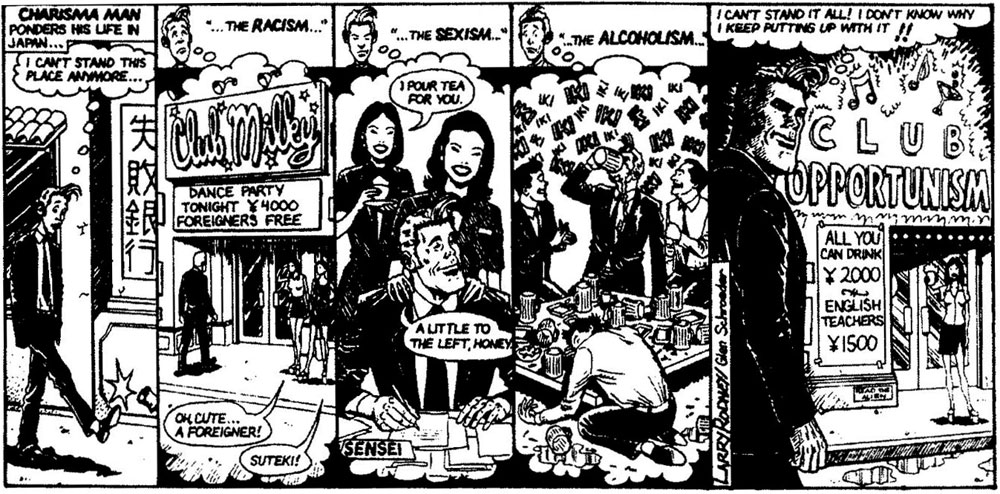Writer: Neil Garscadden
Artist: Larry Rodney
The Alien, 1998-2006
Your reviewer met a real life Charisma Man in Osaka back in 1996. Let’s call him Charlie. Charlie was shaped like a gourd pumpkin, with a mop of greasy black hair, and talked like his mouth was full of marbles. He had skipped out of a very big debt, incurred back in the US. Charlie boasted about this with glee.
Charlie had landed in Japan two years before. There, he had become an English teacher. Charlie had two girlfriends, Kayoko and Kyoko. Those of us who shared a house with Charlie in Moriguchi, a suburb of Osaka on the train corridor to Kyoto, constantly muddled their names. Neither Kayoko nor Kyoko knew of the other’s existence. Disapproving but unwilling to be the snitch, Charlie’s housemates said nothing to either girlfriend. Both Kayoko and Kyoko were nice, smart women in their early 20s with decent English language skills.
One day Charlie announced to everyone that he was engaged. “To who?” we asked. “Kayoko,” said Charlie, a little surprised at being questioned as to who was the lucky girl. (Or did he say “Kyoko”? Let’s go with “Kayoko”.) Kayoko’s parents were very traditional, and Charlie and Kayoko had a Shinto wedding at Heian Jingu shrine in Kyoto. A week before his wedding, Charlie called things off with Kyoko, but only after having sex with her one last time. Charlie said that Kyoko was very upset. Neither Charlie nor his Western guests had any idea of what the Shinto priests said or did during the elaborate ceremony, busy rotating branches clockwise and anti-clockwise. After the wedding, Kayoko went home while Charlie went out drinking with his work friends.
Japan in the 1990s brought out the worst in many foreigners. Many men in particular found themselves in the position of being unexpected rock stars, emissaries of cool Western culture to cloying Japanese fans. They took advantage of it. It was not always the men: in 1997 in the Kinokuniya bookstore near what was the then-enormous Big Man television screen in the now completely revamped Umeda Station in Osaka, your reviewer saw an Dutch woman lead a gaggle of Japanese girls to the English language session. Eavesdropping on a sermon to a barely comprehending Japanese audience about the life-changing significance of the novel Trainspotting was cringeworthy. The Dutch woman abruptly cut the it short when she realised that she also had a Western audience.
But it was mostly men. They were reasonably well-paid as English teachers, and found themselves the subject of adoration by attractive women who would have been unattainable in their home countries, by reason only of being a Westerner.

Kinokuniya also sold a magazine called The Alien. The polite Japanese word for “foreigner” is “gaikokujin” – “foreign country person”. But the word was shortened to “gaijin”, which means “outsider”. “Gaijin” is a little rude, but frequently used by Japanese people to describes Westerners. “The Alien” is an abrupt translation of “gaijin”. Surrounded by a strange culture and most likely illiterate in the local language, The Alien was a respite, a place to go to and share bafflement and bemusement. The Alien falsely assured you that it was not you who was strange. It actually was them.
But The Alien also poked sharp fun at its readers. The Alien‘s ongoing comic strip Charisma Man did this without mercy. People like Charlie were easy game. Charisma Man revealed and stripped away the illusion. When not amongst Western women, the titular Charisma Man was blonde, strapping, with a chiselled jaw. Charisma Man was surrounded by beautiful Japanese girls with long black hair.

Perhaps Charisma Man’s quiff hairstyle appropriately had a little of Cameron Diaz’s special product from the 1998 motion picture, There’s Something About Mary.

The Charisma Man website notes:
The creator of the strip, Larry Rodney, teamed up with a graphic designer friend, Glen Schroeder, both from Canada, to produce the first year of outstanding strips. The strips continued through 2002 with Neil Garscadden doing the writing and Wayne Wilson providing the art work. At the end of 2002, a book containing all the original strips was published and quick sales further documented its appeal. ‘Charisma Man’ has now become common vernacular among ex-pats in Japan and other countries.
Charisma Man has indeed been collected as a series by creators Neil Garscadden and Larry Rodney, but has regrettably sold out.

The Alien could also be too cruel. Foreigners in Japan in the 1990s were confronted by old women suffering from degenerative spondylosis or degenerative lumbar scoliosis. This manifests as severe spinal deformities. Spying one of these women walking about the streets was daily event. They were folded in half and would shuffle by, barely able to look up. The Japanese word for grandmother is “obasan”. The Alien ran a single panel cartoon, offering 101 uses of bent obasans, ranging from ironing boards to chopping blocks. It was not just mean. It was also snooty, because many foreigners these people were rural peasants – they had grown up and spent their lives in an agriculture employment, which involved constant trunk bending. But in an English language class in Tennoji branch of the Nova language school franchise in Osaka in 1997, one obasan told your critic (then a teacher) that she had suffered malnutrition as a consequence of the years-long famine which gripped Japan after the war. She said her earliest childhood memory was running into the street from her home with a futon over her head as Osaka was firebombed, in 1945.
We have no doubt that there are still plenty of Charisma Man – type foreigners in Japan, but even on our last visit in 2012 it seemed that those little old ladies had passed away.

